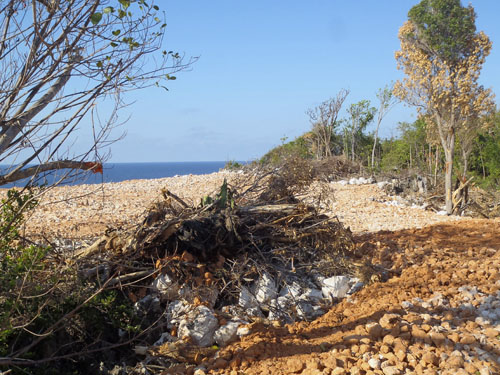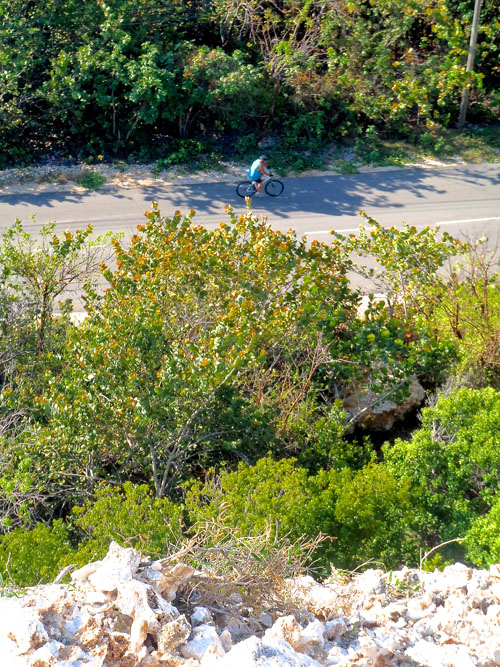URGENT: Setback law required for Cayman Brac bluff edge
A major 2002 study commissioned by government recommended a 100 foot building setback and a 50 foot clearing setback from the edge of the cliff on the south side of the island. (And by extension, all around.) The following scene would have been prevented had this modest request been adopted, which it was not:

Was any attempt to require such a set-back ever attempted? YES. Some builders in the past have told the author that they were required to build a bluff edge house far enough back that not even the roof could be seen from the road below.
But now it is apparent that no such requirement is imposed. We observe structures – and they observe us – built on the very edge. Some structures are viewing platforms, and some are houses. The Development Planning Board (DCB) must have approved them all.
A pause for definitions
Caymanians refer to the high plateau on Cayman Brac as the bluff, and the cliff edge as the bluff edge.
The Development Control Board is an appointed group which conducts closed meetings without any public agenda. Not only is the public not invited, members of the public are not allowed to observe sessions without an invitation. The minutes are published some time after meetings are held.
Cayman Brac is the most-modified island of the three Cayman Islands, and its rate of alteration from forest to streets, roads and buildings is the most rapid. It is located at coordinates 19 north and 79 west.
The 2002 report which recommended a significant protected area and cliff edge set-back laws is called “Management Plan to conserve the brown booby colony and its habitat on Cayman Brac”. The plan addressed two Booby nesting areas as well as the White-tailed tropicbird nesting. The report continues to be, to this day, one of the most comprehensive and significant studies of the natural life of Cayman Brac and the threats to its species and habitat.
Now it’s urgent.
This small story will show the devastation that can occur when a country does not have laws to protect its very nature – the land we live on. Cayman Brac’s situation is even worse than the situation of the other two islands – we have no development plan, and there is a “family compact” of land-owners who appear ready to sell out or convert natural land to streets, roads and unplanned “development”. The DCB appears to be comprised of members of this family compact. There is no local newspaper reporting stories like the following one.
A postscript will list elements of our natural inheritance that should be protected by law, starting with the Fringing Reef and the Beach Ridge – natural protections that on any other sea-girt island would be protected because they are “dikes” that we do not have to build to protect ourselves: they are here already.
News item:
“Boulder Falls Off Clifftop on Cayman Brac, crashes beside main road”



Postscript: The need for protective laws in the Cayman Islands

Do we need other laws too, as well as a set-back law?
Even a first-time visitor will be amazed to learn that the following are not protected:
: the bluff edge and the natural vegetation living there, affording shelter (unless bull-dozed!) for a great list of species including rare plants, boobies and owls;
: the natural “beach ridge” cast up by hurricanes over the eons and protecting us against all but the fiercest hurricanes. (The ’32 Storm cast rocks at Long Beach even higher than the rocks thrown by Hurricane Paloma of 2008.)
: the fringing reef around much of the island. (Even if great waves roll over them, the reef causes them to break, dissipating much of their force.)
: the lovely lands lying beside Old Lighthouse Trail at the eastern tip of the island;
: our inheritance of traditional trails. (All but two have been appropriated for vehicular use, removing their role as safe pedestrian conduits.)
: our natural habitats. (Only the National Trust has set aside natural land to remain in its wild state, for a total of less than 4% of our area. Costa Rica has a target of 40% but our country has no target at all.)
: access to the beach for members of the public: unlike Grand Cayman no small paths have been demarcated by government for all time. Those that existed in the past are unmarked and, except for some use by preservationists, can scarcely be found;
: clear-cutting and burning appear to be unrestrained on Cayman Brac;
: protection of native species against invasive species is close to zero on Cayman Brac (rats, cats, chickens and dogs are found all over the island – no areas are sacrosanct)
: Crown land is not well protected. There are two inalienable kinds: a) the face of the bluff; and b) the beach all around the island, up to the high-water mark. The first has been compromised in many places, with at least four types of invasion. The second is being taken over by some private land-owners, mostly foreign, and further, the right of all to walk the whole beach is being lost with the lack of protection of traditional beach access paths. Both of these responsibilities lie squarely with government, which should be protecting the Queen’s property. The Queen’s representative should raise a question about this!
One reason for these gaps is there is no positive statement of what we want – clean air, clean water both salt and fresh, natural forests and shrublands to give us clean, cool air, dark night skies for study, rest and contemplation. We are lax in international agreements to prevent seaborne pollution from washing up on our beaches; there is no preservation of the right to look up from the beach and see the natural skyline atop the lovely cliffs – on the contrary, traditional houses below are now looked down upon by cliff edge houses and what might be called viewing structures — one man’s “nice view” being another’s scourge.
Who is responsible?
It is a cop-out to say that all of us are responsible, but it is true. We elect people with short term vision, possibly for our own short term gain. But here is the list of who is really responsible. Anyone on this list can begin to correct the glaring vacuum of protection of our land. Those who do not pick up the challenge should be considered derelict in their duties:
The premier and the party in power: are they simply do-nothing people? They pushed through a Conservation Law, albeit a severely watered down one. Are they going to protect our future generations or sit back and let this step falter?
The District Commissioner: One was in office when virtually ALL of the small natural enhancements were performed – trail marking; construction of bird “hides”, historic and other interpretive signs; map-making (showing both natural and historic sites on Cayman Brac); inauguration of an eco-tourism program; publication of guide books. The Mass Grave was cleared and marked – the second most important historic site in the country. The Parrot Reserve was consolidated (using money from the Environmental Fund and other money). Old Lighthouse Trail was restored to daily use. The light beacon itself was faithfully replicated to the standards of the 1937 original. (The Parrot Reserve and the Old Lighthouse Trail remain the most-visited land attractions on Cayman Brac.)
What protective steps have been taken since? Why do we have a District Commissioner, when such offices have been deemed no longer necessary in most countries of the Commonwealth? Is it to help central government wash their hands of Cayman Brac?
“Government”: in other jurisdictions there is more continuity in government. The government should go on despite changes in “the government of the day”. Here, the civil service, which should be ongoing and forceful, appears to be charged with doing whatever the government of the day requests. Where is the tradition of separation of the legislative and the executive branches? Where is the head of the civil service? If the governor is in charge, how often does the governor call the government to task?
Who has allowed the sister islands to go their own way? The Brac bluff is a national treasure, not just the treasure of a small island that may or may not be able to look after itself.
Parliament: Why do you allow 2/50ths of the population to elect 2/15ths of the members of the legislature? Is this the local version of representation by population? It has spoiled the island. It has allowed it to act like The Wild West.
Auditor-General: Where is the office that asks each level, step by step, “What is your mandate? Where is your document? What is your vision of the future? Where is it written?” All of these questions come ahead of what laws are you enforcing? What budget authorization are you following? Where are your financial controls and reports? (Always a problem here.) Where is your plan of accomplishment and the measures of how well you are pursuing it? In short, the fundamental question is “Why are you here?”
The Governor: The queen calls for and receives reports from the prime minister of our mother country. Do you call for and receive reports from ours? Do you ask these penetrating questions? One of your predecessors asked us to write Vision 2008. That was a great step. There is such a thing as putting a colony under administration. I hope it doesn’t come to that. But what if a colony is allowing one of its parts to be blasted, quarried, bulldozed and burned at a rapid rate, without any plan in the world, and without any review except by a closed-door committee?
Poets, writers, visionaries, historians, priests, people in the arts: What? Are we all too busy sticking our hands out for subsidies? Who is raising these questions? Who is describing the lovely, peaceful, educated, safe and thoughtful society that could exist here, surrounded by natural space and protective of our natural endowment?
Each resident. We need to demand more. A healthy democracy is built from the bottom.
Don’t cop out. If your name is on this list (as is the author’s) then act. Ask yourself next month: Have I taken a step to arrest the decline of our favored country?
JWP
25Apr2014
